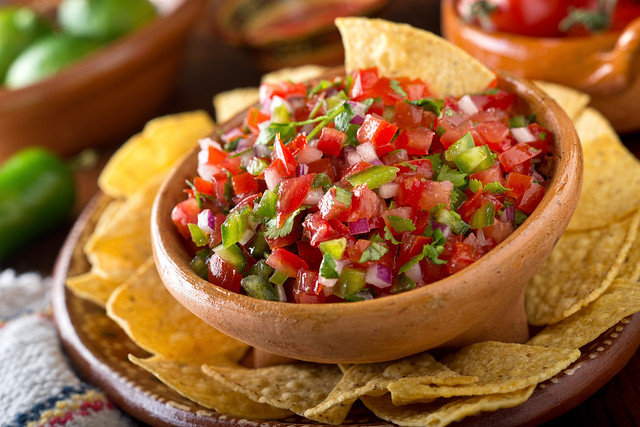
It’s National Salsa Month! If you missed Salsa Day, no worries, Americans enjoy salsa all year long. Use this recipe to create a delicious pairing for chips, eggs, steak, chicken, shrimp, or salmon, and see the latest agricultural statistics for each ingredient. A condiment for all seasons and any meal, salsas range from simple salsa fresca (also known as pico de gallo) to peach salsa. U.S. farmers grow everything you need to make it delicious.
Ingredients:
2 to 3 tomatoes, chopped, or 1 (14.5 ounce) can, diced
According to the National Agricultural Statistics Service (NASS) Vegetables 2019 Summary (PDF, 2.3 MB), farmers dedicated over 282,000 acres to tomato production. Evidently a recipe for success, tomato production reached over $1.6 billion in 2019. Not just a key salsa ingredient, tomatoes compliment a wide variety of family meals.
Canned or processed tomatoes make great salsa, too. Processing tomatoes are grown from special seeds to have characteristics for quality when processed. California leads the nation in exports of processing tomatoes. Over 11,000 tons of processing tomatoes were produced in California in 2019.
1/2 an onion, chopped
Farmers across the United States grow onions. According to the NASS Vegetables 2019 Summary (PDF, 3.4 MB), top growing states include California, Washington, Georgia, Oregon, and New Mexico. In 2019, onions reached just over $1 billion in value, grown on 129,400 U.S. acres. That is a lot of onions, but you don’t need a lot for this recipe.
3 chile peppers, seeded and finely chopped
New Mexico leads the nation in chile pepper production, with 9,100 acres dedicated to the science and art of quality pepper production. According to the latest New Mexico Chile Production Report (PDF, 222 KB), the varietal long hot green harvested acres increased while long milder green acres decreased. Long hot green chile peppers include the famous jalapeño and cayenne types. If you have a sensitivity to these, substitute bell pepper instead.
¼ cup of cilantro, chopped
Cilantro grows across the nation. It grows in the open near the ocean, on inland farms, and in greenhouses. Part of the herb and miscellaneous category in the Census of Agriculture dataset, cilantro provides quite a lot of flavor in a small portion. Some would say that without cilantro, the flavor profile of salsa would be incomplete.
1 lime, juiced
Citrus in general grows well in Arizona, California, Florida, and Texas. California leads the nation in citrus production. In San Diego County alone, farmers grew limes on 253 acres dedicated to the tangy fruit, according to the latest California Citrus Acreage Report.
Make it your own! Add additional fruit, as desired.
Is it possible to make salsa even more fun to eat? Yes, it is. Adding other fruits to your salsa is a way to customize a family recipe and expand your salsa options. American farmers have us covered with a supply of delicious fruits. Here a few to consider adding to your salsa recipe, or substitute for tomatoes.
1 to 2 peaches, peeled, pitted, and diced
Peaches make for a delicious salsa. According to the NASS Noncitrus Fruits and Nuts 2019 Summary (PDF, 1.7 MB), California peach production weighed in at 498,000 tons in 2019, making up a large part of the 681,600 tons grown in the United States overall. The latest peach forecast for 2020 estimates 520,000 tons.
1 to 2 mango, peeled and diced
Another favorite fruit for salsa is mango. According to the latest Hawaii Tropical Fruit and Crops Report (PDF, 232 KB), 273,000 pounds of mango were produced in Hawaii in 2018. Tip: create crisscross cuts on a half, then scoop away from the skin for small cubes of deliciousness to add to your salsa.
1 to 2 papaya, peeled, seeded, and diced
Papaya is primarily grown in the great state of Hawaii. The recent NASS Noncitrus Fruits and Nuts 2019 Summary (PDF, 1.7 MB) shows that Hawaii produced over 11 million pounds of papaya in 2019.
All we can say is bon appetit (and don’t forget to share)! Interested in seeing more recipes? Check out USDA’s ChooseMyPlate.gov. Want to know where more of your favorite ingredients come from? Visit www.nass.usda.gov.


